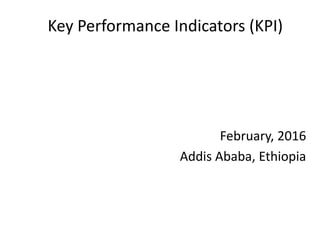
key Performance Indicators very important x.pptx
- 1. Key Performance Indicators (KPI) February, 2016 Addis Ababa, Ethiopia
- 2. Introduction Training Facilitator Jemal Ahmed Certified Senior management development consultant, Researcher and Trainer Mobile: 0911055422 em@il: ahmedjemal5@gmail.com 10/05/2024
- 3. • Definition of KPIs: Key Performance Indicators (KPIs) are quantifiable measurements used to gauge a company’s overall long-term performance • A key performance indicator (KPI) is a quantifiable measure of performance over time for a specific objective.
- 4. • Key Performance Indicators measure the organisational performances that are most critical for the current and future success of an organisation • KPIs help organizations align their teams, track their progress, make data-driven decisions, and optimize their performance.
- 5. • KPIs are a key tool for a leader to help make decisions and guide their teams back on track
- 6. • KPIs are different from metrics, which are more general measures of everyday business • KPIs are the key targets that support the strategic goals of the organization.
- 7. • KPIs specifically help determine a company’s strategic, financial, and operational achievements.
- 8. • • KPIs measure the performance of an going process to achieve a goal or target. • • The KPI must be an indicator to measure the current and future success of the organisation.
- 9. • • A KPI must be understood by all staff and everyone must know what corrective action to take. This corrective action must impact the KPI. • KPIs must be defined using SMART objectives.
- 10. • Purposes of KPIs: KPIs help organizations identify strengths and weaknesses, make data- driven decisions, and optimize performance. • They provide teams with targets to aim for, milestones to gauge progress, and insights to help guide decision-making throughout an organization.
- 11. • KPIs as a Performance Management Tool: KPIs are crucial tools for measuring and tracking the progress of business objectives. • They are used to monitor progress, identify strengths and weaknesses, and make informed decisions.
- 12. • Examples of KPIs: Examples of KPIs include profit margin, customer satisfaction, productive efficiency, throughput, web traffic, click-through rate, customer lifetime value, customer acquisition cost, job satisfaction, revenue growth, revenue per client, client retention rate, total cycle time, error rate, quality rate, etc.
- 13. • - Revenue growth rate: The percentage increase or decrease in revenue over a period of time. • - Customer satisfaction score: The average rating given by customers to a product, service, or company based on surveys or feedback forms.
- 14. • - Employee turnover rate: The percentage of employees who leave the organization voluntarily or involuntarily over a period of time. • - Net promoter score: The percentage of customers who would recommend a product, service, or company to others minus the percentage who would not.
- 15. • - Return on investment: The ratio of net profit to total investment for a project, campaign, or initiative
- 16. • - Financial KPIs: These are indicators that measure the financial health and performance of the organization, such as revenue, profit, cash flow, and budget variance.
- 17. • - Customer KPIs: These are indicators that measure the satisfaction, loyalty, retention, and acquisition of customers, such as customer lifetime value, churn rate, and conversion rate.
- 18. • Employee KPIs: These are indicators that measure the engagement, productivity, retention, and development of employees, such as employee satisfaction score, absenteeism rate, and training hours
- 20. • Functions of KPIs: KPIs provide a focus for strategic and operational improvement, create an analytical basis for decision making, and help focus attention on what matters most.
- 21. Steps to Develop KPIs: 1. Identify and prioritize strategic goals. 2. Select the right KPIs. 3. Link KPIs to strategic goals. 4. Establish a data collection and management system. 5. Define measurement methods and frequency. 6. Create a KPI reporting framework.
- 22. • - Define the strategic goals and objectives of the organization and each department or team. • - Identify the key drivers and outcomes that contribute to the achievement of those goals and objectives. • - Choose the most relevant and meaningful indicators that measure those drivers and outcomes.
- 23. • - Set SMART (specific, measurable, achievable, relevant, and time-bound) targets for each indicator. • - Collect and analyze data regularly to monitor and evaluate the performance of each indicator. • - Communicate and report the results to stakeholders and take action to improve performance if needed.
- 24. • KPIs can also be categorized into short-term and long-term KPIs based on their timeframe. • Short-term KPIs are usually measured on a monthly or quarterly basis and reflect the immediate impact of actions or initiatives. •
- 25. • Long-term KPIs are usually measured on a yearly or multi-year basis and reflect the strategic impact of actions or initiatives.
- 26. • Short Time KPIs: Operational KPIs typically measure performance in a shorter time frame, and are focused on organizational processes and efficiencies.
- 27. • - Operational KPIs: These are low-level indicators that track the efficiency and effectiveness of processes, activities, and tasks within the organization.
- 28. • Strategic KPIs: Strategic KPIs are usually the most high-level. • These types of KPIs may indicate how a company is doing, although it doesn’t provide much information beyond a very high-level snapshot.
- 29. • - Strategic KPIs: These are high-level indicators that monitor the overall performance of the organization in relation to its vision, mission, and values.